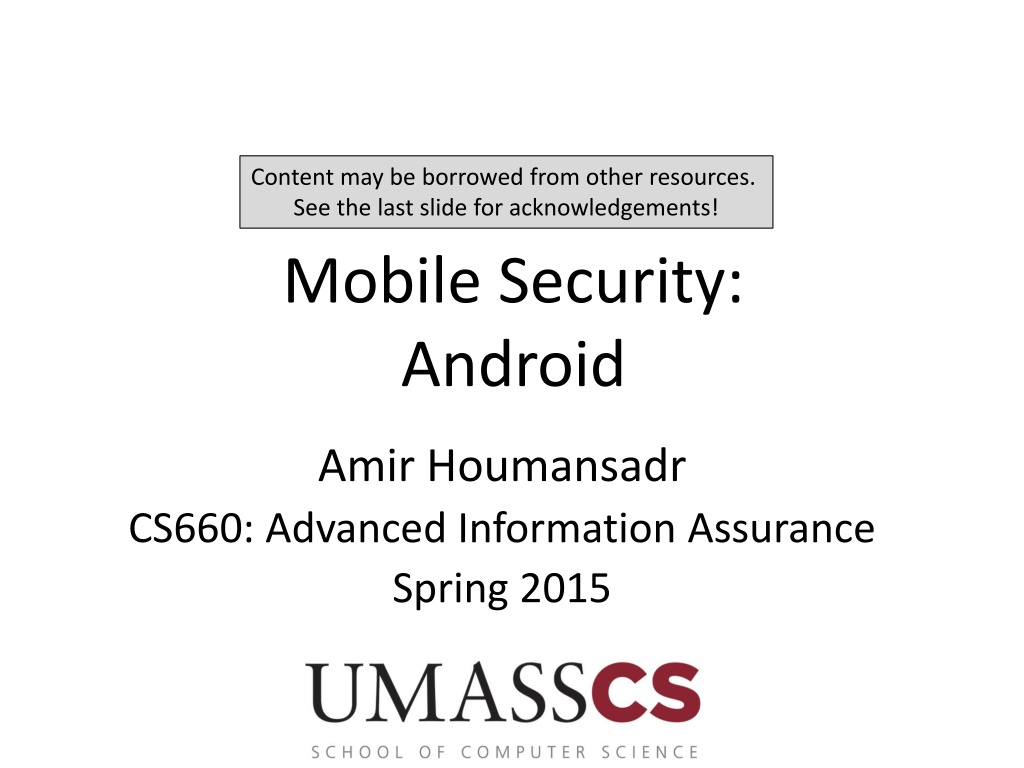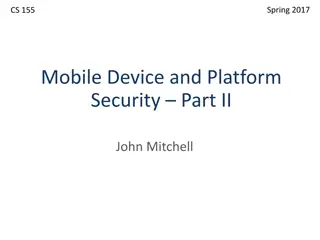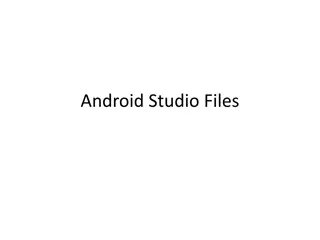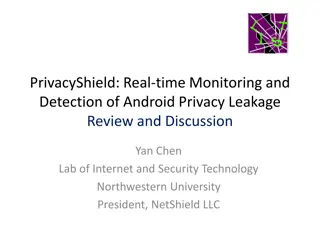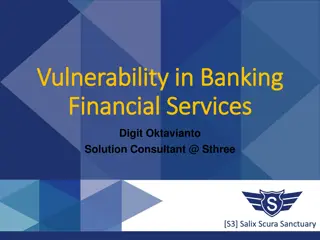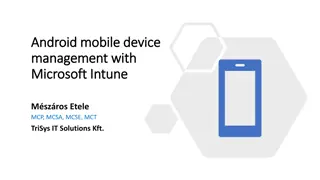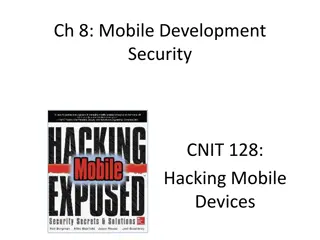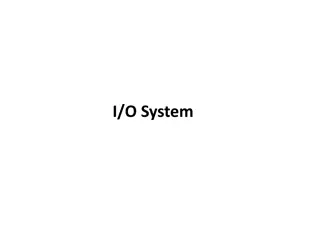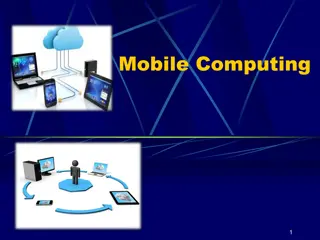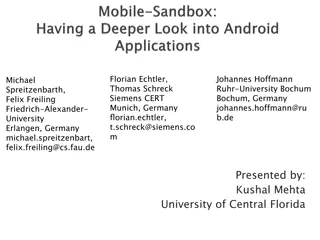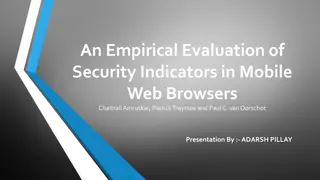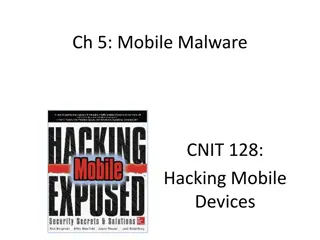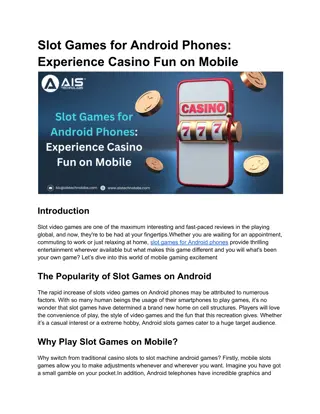Mobile Security: Android Devices and Threats
This content delves into the unique security challenges faced by mobile devices, particularly Android smartphones and tablets. It explores the differences from PC security, the market trends, prevalence of malware on Android, and types of threats encountered in the mobile security landscape.
Download Presentation

Please find below an Image/Link to download the presentation.
The content on the website is provided AS IS for your information and personal use only. It may not be sold, licensed, or shared on other websites without obtaining consent from the author.If you encounter any issues during the download, it is possible that the publisher has removed the file from their server.
You are allowed to download the files provided on this website for personal or commercial use, subject to the condition that they are used lawfully. All files are the property of their respective owners.
The content on the website is provided AS IS for your information and personal use only. It may not be sold, licensed, or shared on other websites without obtaining consent from the author.
E N D
Presentation Transcript
Content may be borrowed from other resources. See the last slide for acknowledgements! Mobile Security: Android Amir Houmansadr CS660: Advanced Information Assurance Spring 2015
Mobile Devices Mobile computers: Mainly smartphones, tablets Sensors: GPS, camera, accelerometer, etc. Computation: powerful CPUs ( 1 GHz, multi-core) Communication: cellular/4G, Wi-Fi, near field communication (NFC), etc. Many connect to the Internet using cellular networks Billions mobile devices sold annually Organization
How is it different from PC security? Limited computing resources Battery, CPU, memory, storage, bandwidth Therefore, we can not use PC solutions right out of the box User education Broader range of users compared to PCs More prone to social attacks Ubiquitous Less expensive, outnumber PCs More interfaces for connectivity Bluetooth, infrared, WiFi, cellular, USB, tethering CS660 - Advanced Information Assurance - UMassAmherst 3
How is it different from PC security? Portable Subject to loss/stealing Subject to short range breaches (WiFi, near field communication (NFC)) Subject to search and seizure Carry sensitive content Your location! Your identity (MAC, Bluetooth address, IMEI, IMSI) Payment apps, financial apps, credit cards Wider range of software (apps) than PCs There s an app for it Untrusted third-party vendors CS660 - Advanced Information Assurance - UMassAmherst 4
Malware Market Android gets 97% of malware! Why? CS660 - Advanced Information Assurance - UMassAmherst 7
Threats by Type CS660 - Advanced Information Assurance - UMassAmherst 8
Research Trends in Mobile Device Security User authentication Passwords, biometrics, etc OS/software attestation Access control/permissions Location privacy Social engineering Covert channels E.g., audio channels CS660 - Advanced Information Assurance - UMassAmherst 9
TaintDroid:An Information- FlowTracking System for Realtime Privacy Monitoring on Smartphones William Enck, Peter Gilbert, Byung-Gon Chun, Landon P. Cox, Jaeyeon Jung, Patrick McDaniel, and Anmol N. Sheth OSDI 10 CS660 - Advanced Information Assurance - UMassAmherst 10
Problem Apps can be installed on a smartphone from GooglePlay, Amazon App store, Mobo-Market etc. All of the apps which don t come with the OS are called third-party apps and hence, are suspicious towards information leakage Monitor when sensitive data is being leaked in real times from the system through third-party applications CS660 - Advanced Information Assurance - UMassAmherst 11
Mobile Device Information Leakage Types of mobile device information sources: Internal to device (e.g., GPS location, IMEI, etc.) External sources (e.g., CNN, Chase Bank, etc.) Third-party mobile apps can leak info Send out device ID (IMEI/EID), contacts, location, etc. Apps ask permission to access such info; users can ignore! Apps can intercept info sent to a source, send to different destination! Motives: Monitor activity Advertisement Market research (include user location, behavior, etc.) Identity theft etc How do we protect against such information leakage?
Challenges for Monitoring Privacy Info Resource constraints E.g. tracking Panorama images would be expensive towards performance Battery consumption Third-party apps are entrusted with several types of private information Sensitive information can be difficult to identify even when it s sent in clear format Geo-location data is a pair of floating point numbers Apps can share information Facebook, twitter, Google search 13
Android background Android is a Linux-based OS All of the core functionality has been written in Java and C/C++ Applications are written in Java and then are converted into Dalvik Executable (DEX) byte code DEX code is executed in Dalvik Virtual Machine (DVM) Applications communicate via binder IPC interface 14
Android background Binder IPC (Inter-Process Communication) Android apps communicate with each other using IPC binder Parcels are fundamental components of IPC framework which serialize data objects before sending it out of VM Binder kernel module passes parcel messages between processes 15
Android background Permissions Some apps don t request for permissions to perform some action, they delegate their job to other apps [applications.androidxiphone.com] 16
Android background Each app on an android phone is run inside new Dalvik VM sandbox Each DVM is assigned a unique user id (uid) All the permissions requested by an app to access phone resources are assigned to uid Uid remains same when an app is run/updated but pid can be different 17
Dynamic Taint Analysis DTA is a technique that tracks information dependencies from an origin High-level: Taint source Taint propagation Taint sink CS660 - Advanced Information Assurance - UMassAmherst 18
Taint Adaptors Taint sources and sinks must be carefully integrated into existing architectural framework Depends on type of information Low-bandwidth sensors: location, accelerometer High-bandwidth sensors: microphone, camera Information databases: address book, SMS data Device identifiers: IMER, IMSI, ICC-ID Network taint sink CS660 - Advanced Information Assurance - UMassAmherst 20
Experimental Setup 30 apps were selected randomly out of 1100 apps, taken 50 most popular apps from each of 22 categories on Android Market Apps were played manually which involved installation, registration if required and exercising the functionality offered by the apps Logs were recorded which included tainted binder messages, tainted file output and tainted network messages Network traffic using tcpdump was also recorded for verification of results 21
Findings: Permissions requested Out of 105 flagged connections, only 37 legitimate 22
Findings: Information Leakage [gizmocrazed.com] 23
Performance All experiments were run on Android 2.1 OS, modified for taintDroid TaintDroid incurs almost the same performance and memory overhead what an original Android OS does [sparkwiz.com] 24
Performance-MacroBenchmarks Load time: The duration between when an app is clicked to launch and an activity is displayed Address Book: An account creation time (3 SQL queries) and read time (2 SQL queries) Phone Call: Duration from pressing dial button to in-call mode Take Picture: Duration from pressing Take Picture button to re-enabling of Preview mode 25
Performance-Java Microbenchmarks Android port of CaffeineMark 3.0 Sieve:The classic sieve of eratosthenes finds prime numbers. Loop: The loop test uses sorting and sequence generation as to measure compiler optimization of loops. Logic:Tests the speed with which the virtual machine executes decision- making instructions. Method:The Method test executes recursive function calls to see how well the VM handles method calls. Float:Simulates a 3D rotation of objects around a point. [benchmarkhq.ru] 26
Performance-Java Microbenchmarks Android port of CaffeineMark 3.0 Scores indicate roughly the number of Java instructions executed per second 27
Performance-IPC Benchmarks Client and service applications were developed which perform binder transactions as fast as possible Service manipulates account object (username: String, balance: Integer) by provided interfaces: getAccount() and setAccount() Experiment measures the time for client to invoke interface pair 1000 times 28
Limitations It is a firmware modification, not an app Only tracks explicit data flows CS660 - Advanced Information Assurance - UMassAmherst 29
Acknowledgement Some of the slides, content, or pictures are borrowed from the following resources, and some pictures are obtained through Google search without being referenced below: 1. TaintDroid presentation by the authors at OSDI 10 2. TaintDroid presentation by Mohsen Junaid 3. Mobile Device Security CS660 - Advanced Information Assurance - UMassAmherst 30
